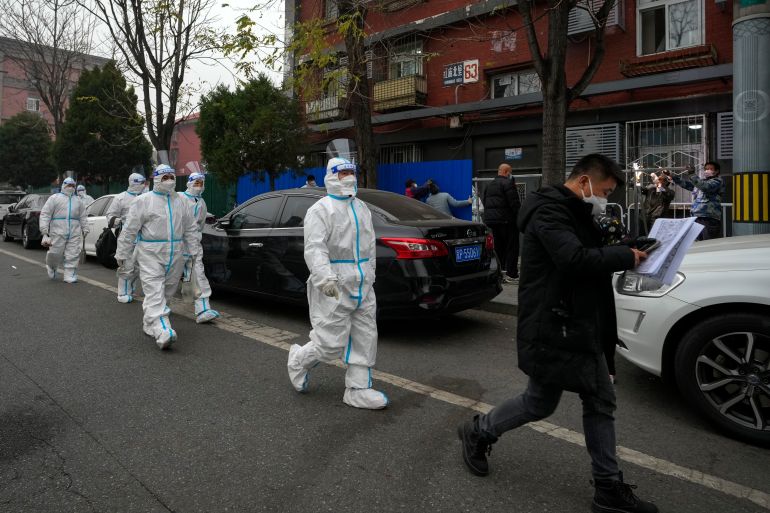‘New-found freedom’: China relaxes COVID rules after protests
Local governments are allowing positive coronavirus cases to quarantine at home – a marked departure from current zero-COVID rules.

Cities across China have further unwound COVID restrictions, loosening testing and quarantine rules after nationwide demonstrations calling for an end to lockdowns and greater political freedoms.
Anger and frustration with China’s hardline pandemic response spilled onto the streets last weekend in widespread protests not seen in decades.
Keep reading
list of 4 itemsHazmat suit-clad riot police confront China COVID-19 protesters
China softens COVID stance after protests, clashes with police
What’s next for China’s anti-lockdown protests?
China’s vast security apparatus moved swiftly to smother the demonstrations, deploying a heavy police presence and boosting online censorship and surveillance of the population.
A number of cities also began loosening COVID restrictions, such as moving away from daily mass testing requirements – a tedious mainstay of life under Beijing’s stringent zero-COVID policy.
But sporadic localised clashes have continued to flare up.
Social media footage posted on Thursday night showed dozens of people clashing with health workers in white hazmat suits outside a middle school in Yicheng, in central China’s Hubei province.
The author of the post said people in the video were parents of students who tested positive for the virus and had been taken to central quarantine.
In one video, parents are seen kneeling in front of the school gate, pleading to take their children home, and another video showed at least a dozen police officers at the scene.
Home quarantine?
Signs have emerged of a possible shift in the policy of sending positive cases to central quarantine.
An analysis by the state-run newspaper People’s Daily on Friday quoted a number of health experts supporting local government moves to allow positive cases to quarantine at home, which would be a marked departure from current rules.
When called on Friday, some officials from local communities in the Chaoyang district of Beijing said people who tested positive there would no longer have to go to central quarantine.
Central government officials have signalled a broader relaxation of the zero-COVID policy could be in the works.
Speaking at the National Health Commission on Wednesday, Vice Premier Sun Chunlan said the Omicron variant was weakening and vaccination rates were improving, according to the state-run Xinhua news agency.
A central figure behind Beijing’s pandemic response, Sun said this “new situation” required “new tasks”.
Testing loosens up
As of Friday, the southwestern metropolis of Chengdu will no longer require a recent negative test result to enter public places or ride the metro, instead only demanding a green health code confirming people have not travelled to a “high risk” area.
In Beijing, health authorities called on hospitals not to deny treatment to people without a negative PCR test taken within 48 hours.
In January, a pregnant woman in the city of Xi’an miscarried after being refused hospital entry for not having a PCR test result.
China has seen a string of deaths after treatment was delayed by COVID restrictions, including the recent death of a four-month-old baby who was stuck in quarantine with her father.
Those cases became a rallying cry during the protests, with a viral post listing the names of those who died because of alleged negligence linked to the pandemic response.
Many other cities with virus outbreaks are allowing restaurants, shopping malls and even schools to reopen, in a clear departure from previous tough lockdown rules.
In northwestern Urumqi, where a fire that killed 10 people spurred anti-lockdown protests, authorities announced on Friday that supermarkets, hotels, restaurants, and ski resorts would gradually be opened.
The city of more than four million endured one of China’s longest lockdowns, with some areas shut in early August.
‘I can only pray’
Further easing of COVID-19 testing requirements and quarantine rules in some Chinese cities was met with a mix of relief and worry on Friday, as hundreds of millions await an expected shift in national virus policies after widespread social unrest.
The looser measures were welcomed by workers frustrated by three years of economically damaging curbs, but have jolted others who suddenly feel more exposed to a disease authorities consistently described as deadly until this week.
The elderly, many of whom are still unvaccinated, feel the most vulnerable.
Shi Wei, a Beijing resident suffering from lymphatic cancer, spends most of his time isolating, but still worries about getting COVID-19 and giving it to his 80-year-old mother as he goes out for hospital treatment every three weeks.
“I can only pray God protects me,” he said.
China’s COVID policies have stifled everything from domestic consumption to factory output and global supply chains, and have inflicted severe mental stress on hundreds of millions of people.
Many communities designated high risk by various cities remain under lockdown, and many people are still required to take daily tests.
“The uplifted mood isn’t universal,” a Guangzhou-based diplomat said. “Although a lot of people are enjoying new-found freedom, it’s worth noting that there are still hundreds of high-risk zones that are locked down throughout the city.”